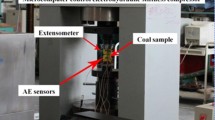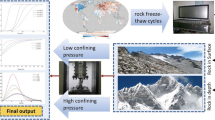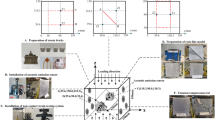Abstract
A fundamental study on the tensile failure of rock is conducted using the three-dimensional lattice spring model. The model covers three aspects: (1) the relationship between the mesoscopic tensile/shear failure and the corresponding macroscopic tensile failure; (2) the effects of the size, shape, and location of the initial defect on the macroscopic tensile failure; and (3) the effects of the porosity, heterogeneity, crystal structure, mesoscopic constitutive model, and model scale on its macroscopic tensile responses. Through investigation, this study reveals that the mesoscopic strength heterogeneity affects the macroscopic pre-peak response of rock, and the initial defect could control its macroscopic post-peak response. The post-peak characteristics of the mesoscopic constitutive model influence both the macroscopic pre-peak and post-peak responses, which are scale independent and scale dependent, respectively. Based on these investigations, a parameter-selection method for the mesoscopic constitutive model is established to fully utilize the macroscopic tensile experimental data.



















Similar content being viewed by others
Abbreviations
- \(D\left( \cdot \right)\) :
-
The damage amount of the spring bond
- \({D_{\text{n}}}\left( \cdot \right)\) :
-
The damage function of the normal spring
- \({D_{\text{s}}}\left( \cdot \right)\) :
-
The damage function of the shear spring
- \(f\left( \cdot \right)\) :
-
A mathematic function for damage description
- \({{\mathbf{F}}_{{\text{n}},ij}}\) :
-
The normal interaction forces (vectors)
- \({{\mathbf{F}}_{{\text{s,}}ij}}\) :
-
The shear interaction forces (vectors)
- \({k_{\text{n}}}\) :
-
The shiftiness of the normal spring
- \({k_{\text{s}}}\) :
-
The shiftiness of the shear spring
- \(\bar {l}\) :
-
The mean length of the spring bond in the lattice model
- \(l_{i}^{{}}\) :
-
The length of the i-th spring bond in the lattice model
- \(m\) :
-
A shape coefficient of the Weibull distribution
- \({m_p}\) :
-
The particle mass
- \({\mathbf{n}}\) :
-
The initial unit vector of the connected particles
- \({{\mathbf{n}}_s}\) :
-
The direction unit vector of the tangential deformation of the spring bond
- \({{\mathbf{u}}_i}\) :
-
The displacement of particle\(i\)
- \({{\mathbf{u}}_j}\) :
-
The displacement of particle\(j\)
- \({{\mathbf{u}}_{{\text{n}},ij}}\) :
-
The relative normal deformation vector between particles
- \({{\mathbf{u}}_{{\text{s}},ij}}\) :
-
The relative tangential deformation vector between particles
- \({\mathbf{\dot {u}}}\) :
-
The particle velocity
- \({u_{\text{n}}}\) :
-
The normal deformations of the spring
- \(u_{{\text{n}}}^{*}\) :
-
The maximum tensile deformation of the spring
- \({u_{\text{s}}}\) :
-
The tangential deformations of the spring
- \(\left| {{u_{\text{s}}}} \right|\) :
-
The absolute value of the shear deformation
- \(u_{{\text{s}}}^{*}\) :
-
The maximum shear deformation of the spring
- \({u^ * }\) :
-
The ultimate deformation
- \(u\) :
-
The current deformation
- \(\upsilon\) :
-
The Poisson’s ratio
- \(V\) :
-
The represented macroscopic volume of the computational model
- \(x\) :
-
The non-dimensional spring deformation
- \({x_i}\) :
-
The initial coordinate of particle \(i\)
- \({y_i}\) :
-
The initial coordinate of particle \(i\)
- \({z_i}\) :
-
The initial coordinate of particle \(i\)
- \({x_j}\) :
-
The initial coordinate of particle \(j\)
- \({y_j}\) :
-
The initial coordinate of particle \(j\)
- \({z_j}\) :
-
The initial coordinate of particle \(j\)
- \(\Delta t\) :
-
The time step
- \(\alpha\) :
-
A non-dimensional parameter for the mesoscopic constitutive model
- \(\beta\) :
-
A parameter for the mesoscopic constitutive model
- \(\zeta\) :
-
A random number that satisfies a certain distribution
- \({\xi _i}\) :
-
The random number assigned to particle i
- \({\xi _j}\) :
-
The random number assigned to particle j
- \({\xi ^{{\text{3D}}}}\) :
-
The lattice coefficient
- \({\left[ \varepsilon \right]_{{\text{bond}}}}\) :
-
The local strain of a spring bond
- \({\bar {\sigma }_t}\) :
-
The macroscopic tensile strength
- \(\sigma _{t}^{{}}\) :
-
The macroscopic tensile strength
- \(\lambda\) :
-
A scale increase factor
References
Barnhoorn A, Bystricky M, Kunze K, Burlini L, Burg JP (2005) Strain localisation in bimineralic rocks: experimental deformation of synthetic calcite–anhydrite aggregates. Earth Planet Sci Lett 240(3):748–763
Camacho GT, Ortiz M (1996) Computational modelling of impact damage in brittle materials. Int J Solids Struct 33(20–22):2899–2938
Christensen RM (2016) Perspective on materials failure theory and applications. J Appl Mech 2016:83
Espinosa HD, Zavattieri PD (2003) A grain level model for the study of failure initiation and evolution in polycrystalline brittle materials. Part II: numerical examples. Mech Mater 35(3–6):365–394
He M, Zhao F (2013) Laboratory study of unloading rate effects on rockburst. Disaster Adv 6(9):11–18
Heuze FE (1983) High-temperature mechanical, physical and thermal properties of granitic rocks—a review. Int J Rock Mech Min 20(1):3–10
Hofmann DC, Suh JY, Wiest A et al (2008) Designing metallic glass matrix composites with high toughness and tensile ductility. Nature 451(7182):1085–1089
Hrennikoff A (1941) Solution of problems of elasticity by the framework method. ASME J Appl Mech 1941:A619-A715
Li D, Wong LNY (2013) The Brazilian disc test for rock mechanics applications: review and new insights. Rock Mech Rock Eng 46(2):269–287
Meakin P (1991) Models for material failure and deformation. Science 252(5003):226
Okubo S, Fukui K (1996) Complete stress-strain curves for various rock types in uniaxial tension. Int J Rock Mech Min 33(6):549–556
Perić D, Zhao G, Khalili N (2014) Strain localization in unsaturated elastic-plastic materials subjected to plane strain compression. J Eng Mech 140(7):04014050
Potyondy DO, Cundall PA (2004) A bonded-particle model for rock. Int J Rock Mech Min 41(8):1329–1364
Tang CA, Wong RHC, Chau KT, Lin P (2005) Modeling of compression-induced splitting failure in heterogeneous brittle porous solids. Eng Fract Mech 72(4):597–615
Tvergaard V (1990) Effect of fibre debonding in a whisker-reinforced metal. Mater Sci Eng A 125(2):203–213
Wang SY, Sloan SW, Sheng DC, Tang CA (2016) 3D numerical analysis of crack propagation of heterogeneous notched rock under uniaxial tension. Tectonophysics s 677–678:45–67
Wu Z, Fan L, Liu Q et al (2016) Micro-mechanical modeling of the macro-mechanical response and fracture behavior of rock using the numerical manifold method. Eng Geol 225:49
Xu XP, Needleman A (1994) Numerical simulations of fast crack growth in brittle solids. J Mech Phys Solids 42(9):1397–1434
Yang SQ (2015) Discrete element modeling on fracture coalescence behavior of red sandstone containing two unparallel fissures. Eng Geol 178(6):28–48
Yu MH (2004) Advances in strength theories for materials under complex stress state in the 20th century. Adv Mech 34(4):529–560
Zhao GF (2017) Develo** a four-dimensional lattice spring model for mechanical responses of solids. Comput Meth Appl Mech Eng 315:881–895
Zhao GF, **a KW (2018) A study of mode-I self-similar dynamic crack propagation using a lattice spring model. Comput Geotech 96:215–225
Zhao G, Fang J, Zhao J (2011) A 3D distinct lattice spring model for elasticity and dynamic failure. Int J Numer Anal Methods Geomech 35(8):859–885
Zhao GF, Russell AR, Zhao X, Khalili N (2014) Strain rate dependency of uniaxial tensile strength in gosford sandstone by the distinct lattice spring model with X-ray micro CT. Int J Solids Struct 51(7–8):1587–1600
Acknowledgements
This research is financially supported by the National Key Research and Development Program of China (2016YFC0401900), National Natural Science Foundation of China (U1765202, 1177020290) and Program of Introducing Talents of Discipline to Universities (B14012).
Author information
Authors and Affiliations
Corresponding author
Additional information
Publisher’s Note
Springer Nature remains neutral with regard to jurisdictional claims in published maps and institutional affiliations.
Rights and permissions
About this article
Cite this article
Li, Q., Zhao, GF. & Lian, J. A Fundamental Investigation of the Tensile Failure of Rock Using the Three-Dimensional Lattice Spring Model. Rock Mech Rock Eng 52, 2319–2334 (2019). https://doi.org/10.1007/s00603-018-1702-z
Received:
Accepted:
Published:
Issue Date:
DOI: https://doi.org/10.1007/s00603-018-1702-z




